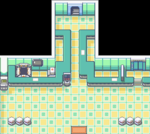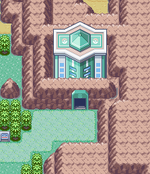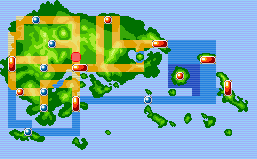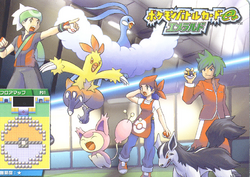Trainer Hill (Japanese: トレーナーヒル Trainer Hill) is a facility in Pokémon Emerald located just north of Mauville City, on Route 111. Much like Trainer Tower in the Sevii Islands on Pokémon FireRed and LeafGreen, Trainer Hill is a tower designed for Trainers to race and battle through quickly. The concept remains mostly unchanged from the Trainer Tower: each battle mode has a default time and if beaten, offers a rare in-game item as prizes. The player's Pokémon will not be healed between battles, though recovery items such as Revives and Potions can be used both during and between battles. Unlike Trainer Tower however, the prizes here vary depending on the time taken, and all battles conducted here are Double Battles (although the player can battle each of the two opponents separately in some rooms). Instead of different battle types, the modes here escalate in difficulty.
Trainer Hill also has a Pokémon Center and a Poké Mart inside of it. Since there are Trainers with Pokémon that are not in Hoenn's regional Pokédex, such as Moltres, Trainer Hill's challenge will be closed until the player has entered the Hall of Fame, except in the Japanese version.
Battles conducted inside of Trainer Hill do not award experience or money. The level of the Pokémon used by Trainers will also match the player's highest-leveled Pokémon.
In the original Japanese release of Pokémon Emerald, Trainer Hill also serves as a facility with compatibility for the e-Reader, like Trainer Tower in Pokémon FireRed and LeafGreen. Cards from the Pokémon Battle e Emerald set can be used to modify the Trainers the player can battle, as well as the floor layout, and the top prize they can earn. The default layout of Trainer Hill in the Japanese version has two floors with the same Trainers on each floor for each playthrough. Scanning cards can increase this to a maximum of four floors. The set of Pokémon that each scanned Trainer will use is also dependent on whether they were scanned first or second for that floor.
The Trainers and individual floor layouts featured in the localizations are taken from the cards found in the Pokémon Battle e Emerald set.
Modes (Japanese version)
Default
1F
| Trainer
|
Pokémon
|
|
|
|
|
|
|
|
|
|
|
|
|
|
|
|
|
| Trainers with a PokéNav by their names will be registered in the Trainer's Eyes or Match Call function after the first battle, and may have a rematch with the player with higher-level Pokémon.
|
2F
| Trainer
|
Pokémon
|
|
|
|
|
|
|
|
|
|
|
|
|
|
|
|
|
| Trainers with a PokéNav by their names will be registered in the Trainer's Eyes or Match Call function after the first battle, and may have a rematch with the player with higher-level Pokémon.
|
Replacement Trainers
In the event that an odd number of cards are scanned, the game will place a preset Trainer alongside the last Trainer scanned, as two are always required for one particular floor. The amount of cards scanned will influence this preset Trainer:
- if only one card is scanned, it will cause a Trainer to appear on the first floor;
- three cards will make a Trainer appear on the second floor;
- five cards will make a Trainer appear on the third floor;
- seven cards will make a Trainer appear on fourth floor.
The preset Trainer is the same for each individual floor.
1F
| Trainer
|
Pokémon
|
|
|
|
|
|
|
|
| Trainers with a PokéNav by their names will be registered in the Trainer's Eyes or Match Call function after the first battle, and may have a rematch with the player with higher-level Pokémon.
|
2F
| Trainer
|
Pokémon
|
|
|
|
|
|
|
|
| Trainers with a PokéNav by their names will be registered in the Trainer's Eyes or Match Call function after the first battle, and may have a rematch with the player with higher-level Pokémon.
|
3F
| Trainer
|
Pokémon
|
|
|
|
|
|
|
|
| Trainers with a PokéNav by their names will be registered in the Trainer's Eyes or Match Call function after the first battle, and may have a rematch with the player with higher-level Pokémon.
|
4F
| Trainer
|
Pokémon
|
|
|
|
|
|
|
|
| Trainers with a PokéNav by their names will be registered in the Trainer's Eyes or Match Call function after the first battle, and may have a rematch with the player with higher-level Pokémon.
|
Modes (international versions)
Normal Mode
The top prize for a fast time in this mode is TM11, Sunny Day.
The tower layout in this mode can be recreated in the Japanese version by scanning cards #17-24 in ascending numerical order.
1F
| Trainer
|
Pokémon
|
|
|
|
|
|
|
|
|
|
|
|
|
|
|
| Trainers with a PokéNav by their names will be registered in the Trainer's Eyes or Match Call function after the first battle, and may have a rematch with the player with higher-level Pokémon.
|
2F
| Trainer
|
Pokémon
|
|
|
|
|
|
|
|
|
|
|
|
|
|
|
| Trainers with a PokéNav by their names will be registered in the Trainer's Eyes or Match Call function after the first battle, and may have a rematch with the player with higher-level Pokémon.
|
3F
| Trainer
|
Pokémon
|
|
|
|
|
|
|
|
|
|
|
|
|
|
|
| Trainers with a PokéNav by their names will be registered in the Trainer's Eyes or Match Call function after the first battle, and may have a rematch with the player with higher-level Pokémon.
|
4F
| Trainer
|
Pokémon
|
|
|
|
|
|
|
|
|
|
|
|
|
|
|
| Trainers with a PokéNav by their names will be registered in the Trainer's Eyes or Match Call function after the first battle, and may have a rematch with the player with higher-level Pokémon.
|
Variety Mode
The top prize for a fast time in this mode is an Elixir.
The tower layout in this mode can be recreated in the Japanese version by scanning cards #41-48 in ascending numerical order.
1F
| Trainer
|
Pokémon
|
|
|
|
|
|
|
|
|
|
|
|
|
|
|
| Trainers with a PokéNav by their names will be registered in the Trainer's Eyes or Match Call function after the first battle, and may have a rematch with the player with higher-level Pokémon.
|
2F
| Trainer
|
Pokémon
|
|
|
|
|
|
|
|
|
|
|
|
|
|
|
| Trainers with a PokéNav by their names will be registered in the Trainer's Eyes or Match Call function after the first battle, and may have a rematch with the player with higher-level Pokémon.
|
3F
| Trainer
|
Pokémon
|
|
|
|
|
|
|
|
|
|
|
|
|
|
|
| Trainers with a PokéNav by their names will be registered in the Trainer's Eyes or Match Call function after the first battle, and may have a rematch with the player with higher-level Pokémon.
|
4F
| Trainer
|
Pokémon
|
|
|
|
|
|
|
|
|
|
|
|
|
|
|
| Trainers with a PokéNav by their names will be registered in the Trainer's Eyes or Match Call function after the first battle, and may have a rematch with the player with higher-level Pokémon.
|
Unique Mode
The top prize for a fast time in this mode is TM19, Giga Drain.
The tower layout in this mode can be recreated in the Japanese version by scanning cards #49-54 in ascending order, then #56, then #55. The last two cards are in reverse order to prevent a bug that exists with the floor layout of card #55, where a player could become trapped by engaging the Trainers in battle and then moving in a particular way afterward.[1]
1F
| Trainer
|
Pokémon
|
|
|
|
|
|
|
|
|
|
|
|
|
|
|
| Trainers with a PokéNav by their names will be registered in the Trainer's Eyes or Match Call function after the first battle, and may have a rematch with the player with higher-level Pokémon.
|
2F
| Trainer
|
Pokémon
|
|
|
|
|
|
|
|
|
|
|
|
|
|
|
| Trainers with a PokéNav by their names will be registered in the Trainer's Eyes or Match Call function after the first battle, and may have a rematch with the player with higher-level Pokémon.
|
3F
| Trainer
|
Pokémon
|
|
|
|
|
|
|
|
|
|
|
|
|
|
|
| Trainers with a PokéNav by their names will be registered in the Trainer's Eyes or Match Call function after the first battle, and may have a rematch with the player with higher-level Pokémon.
|
4F
| Trainer
|
Pokémon
|
|
|
|
|
|
|
|
|
|
|
|
|
|
|
| Trainers with a PokéNav by their names will be registered in the Trainer's Eyes or Match Call function after the first battle, and may have a rematch with the player with higher-level Pokémon.
|
Expert Mode
The top prize for a fast time in this mode is TM31, Brick Break.
The tower layout in this mode can be recreated in the Japanese version by scanning cards #57-64 in ascending numerical order.
1F
| Trainer
|
Pokémon
|
|
|
|
|
|
|
|
|
|
|
|
|
|
|
| Trainers with a PokéNav by their names will be registered in the Trainer's Eyes or Match Call function after the first battle, and may have a rematch with the player with higher-level Pokémon.
|
2F
| Trainer
|
Pokémon
|
|
|
|
|
|
|
|
|
|
|
|
|
|
|
| Trainers with a PokéNav by their names will be registered in the Trainer's Eyes or Match Call function after the first battle, and may have a rematch with the player with higher-level Pokémon.
|
3F
| Trainer
|
Pokémon
|
|
|
|
|
|
|
|
|
|
|
|
|
|
|
| Trainers with a PokéNav by their names will be registered in the Trainer's Eyes or Match Call function after the first battle, and may have a rematch with the player with higher-level Pokémon.
|
4F
| Trainer
|
Pokémon
|
|
|
|
|
|
|
|
|
|
|
|
|
|
|
| Trainers with a PokéNav by their names will be registered in the Trainer's Eyes or Match Call function after the first battle, and may have a rematch with the player with higher-level Pokémon.
|
Poké Mart
Prizes
Each prize can be obtained an unlimited number of times. If playing in Japanese, no prizes will be awarded regardless of completion time unless the challenge covers all four possible floors, which requires at least 7 e-Reader cards to be scanned; the default layout contains only two floors and does not qualify for prizes.
Determining the grand prize
The top prize, for clearing all four floors in less than 12 minutes, depends on the particular combination of cards that are used. Let  be the card numbers in a particular layout. If only seven cards are used, then the eighth trainer is a default trainer, and
be the card numbers in a particular layout. If only seven cards are used, then the eighth trainer is a default trainer, and  becomes 0.
becomes 0.
For each card number, the game takes a modified copy of that card number that uses only the lowest five bits, limiting each modified card number to be in the range 0-31. So let  and so on for the rest of the cards.
and so on for the rest of the cards.
The eight modified card values are then combined together using the bitwise XOR operator, similar to the manner in which Shiny Pokémon are determined. Let  , so that X is also within the range 0-31.
, so that X is also within the range 0-31.
If either  is 0 or if the player has not yet defeated the Champion, then the grand prize index
is 0 or if the player has not yet defeated the Champion, then the grand prize index  , giving a result between 0 and 4. Otherwise (if all eight cards are used and the player has defeated the Champion at least once before),
, giving a result between 0 and 4. Otherwise (if all eight cards are used and the player has defeated the Champion at least once before),  , giving a result between 0 and 9. In the cases where P is 5 or greater, the game also uses the sum
, giving a result between 0 and 9. In the cases where P is 5 or greater, the game also uses the sum  to determine the grand prize:
to determine the grand prize:
Note that the calculation of  and
and  has the property that scanning the same set of eight cards, but in a different order, will never change the prize that is awarded.
has the property that scanning the same set of eight cards, but in a different order, will never change the prize that is awarded.
Grand prize from predefined layouts
In languages other than Japanese, the layout of Trainer Hill can only be customized to a limited extent, by choosing between four predefined modes. Each mode corresponds to a sequence of eight consecutive cards, and the grand prize can be calculated from those card numbers using the same formula:
Layout
| Mode
|
Entrance
|
1F
|
2F
|
3F
|
4F
|
Roof
|
| Normal
|


|

|

|

|

|

|
| Variety
|

|

|

|

|
| Unique
|

|

|

|

|
| Expert
|

|

|

|

|
|
|
Trivia
- Although the player does not gain money or experience like other battle facilities, a Pokémon can still gain and lose friendship in Trainer Hill, such as through walking around or having the Pokémon faint.
In other languages































































